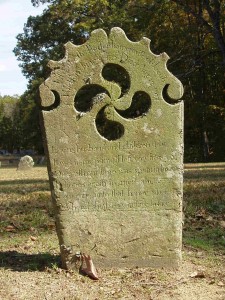Abbotts Creek Primitive Baptist Church was established in 1756, and its cemetery is the site of over 30 beautiful and unusual grave markers. An article published in the High Point Enterprise newspaper in September 2011 talked about the markers’ history:
What makes the decorative tombstones so unique is that the markers, made of soft soapstone, were carved and pierced by Anglo-German cabinet- and furniture-makers — in the German folk art tradition — using the same tools they used to make furniture. “These tombstones are found at only seven churches, and they’re all in Davidson County…. They’re found in no other state and nowhere else in the world, as far as we can tell… Abbots Creek Primitive Baptist Church Cemetery … [is] one of the oldest of the seven sites that have the tombstones, and because it has the largest concentration of the tombstones (more than 30)…. The history of the area is well-documented — including the history of the Germans who settled there in the mid-1700s…. One of the best-known of the craftsmen responsible for the tombstones was John Swicegood, a third-generation craftsman who was born in Davidson County in 1796. Like most of the cabinet- and furniture-makers of that era, Swicegood made coffins and tombstones to supplement his income … The tombstones bear many of the same characteristics and German symbols as the furniture made during that era, such as broken arches, commas, hearts, vine insignias, tulips and fylfot crosses. Article in the High Point Enterprise
A later article in the High Point Enterprise, dated 9 October 2011, had the following quote:
High Point’s Penn Wood, who is so great documenting his historical research, spoke of both the history of the rare tombstones, but also of the Abbott’s Creek Primitive Baptist Church. Wood said, “The Abbott’s Church lies in the rolling frontier known then as the back country and just outside of the town limits of Browntown. Today nothing remains of this historic town on the banks of Abbott’s Creek overlooking Swicegood’s Sawmill, except this cemetery, the town’s only remnant and many of its residents lie buried here.” It is interesting to note that in the mid 1800’s Browntown was almost as large as Charlotte. Wood spoke of the different “schools” of cabinetry and stone carving including the Davidson County School and the Swicegood schools of style. The German influence in the carvings was indicated by such symbols as a tulip representing life, love and immortality. Children’s markers often had a bird in the design. Almost miraculously, these artistic and historic grave markers, “after 200 years remain in good shape despite the fact that soapstone literally decays and wears away with age and weather.” full article
- JOURNAL of DECORATIVE ARTS, November, 1977, Volume III, Number 2, starting at page 24: A Study of Baroque- and Gothic-Style Gravestones in Davidson County, North Carolina, by Bradford L. Rauschenberg
Use your browser’s search function and not the site search function to search for “Abbotts.”

